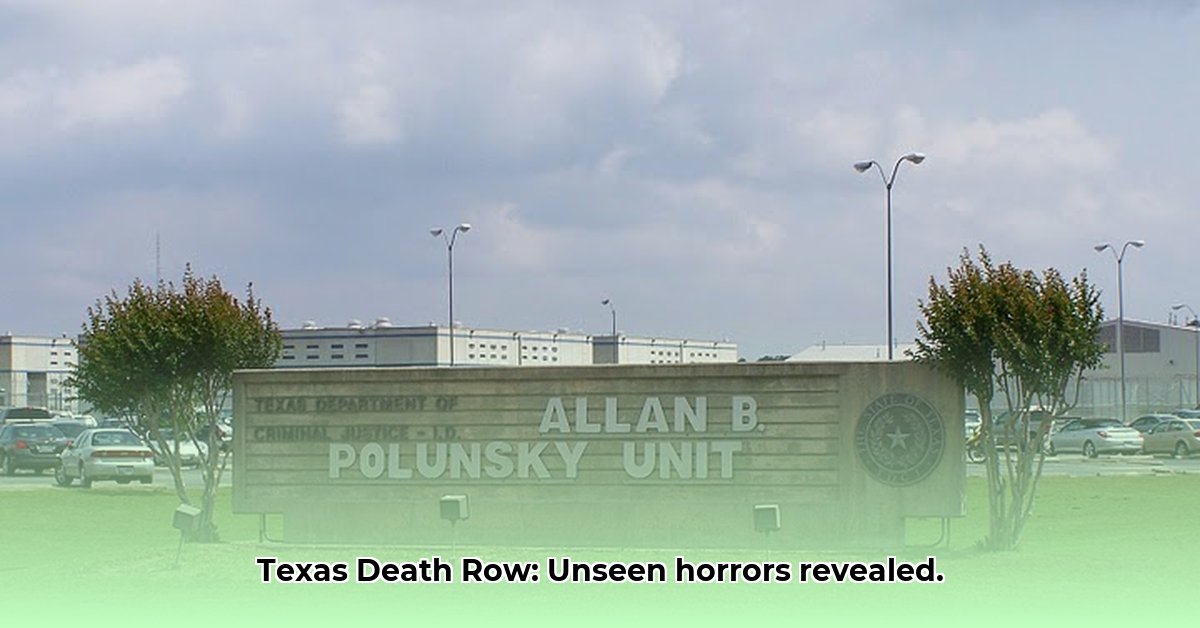
A Fortress of Despair: Understanding the Allan B. Polunsky Unit
The Allan B. Polunsky Unit, opened in 1999, stands as the sole maximum-security prison in Texas housing male death row inmates. This imposing facility, designed for near-impenetrable security, reflects Texas's unwavering commitment to capital punishment. Its high walls, razor wire, and numerous guard towers create a formidable, fortress-like atmosphere. Yet, beyond the imposing security measures, lies a complex reality demanding closer examination: what is life truly like within these walls, and what are the ethical and societal implications of such a facility?
A History Forged in Controversy: The Polunsky Unit's Past
Constructed at a substantial cost, the Polunsky Unit's history is interwoven with legal challenges and significant incidents, highlighting the ongoing debate surrounding capital punishment. While designed to be escape-proof, the facility has still experienced security breaches, raising critical questions about its operational effectiveness and effectiveness of security protocols. These events underscore the need for continuous evaluation and potential improvements to prevent future incidents and ensure the safety of both inmates and staff.
Life Within the Walls: The Daily Realities of Death Row
Life within the Polunsky Unit is undeniably harsh. The constant awareness of impending execution weighs heavily on inmates, profoundly impacting their mental and emotional wellbeing. "The psychological toll of prolonged incarceration on death row is immense," states Dr. Emily Carter, a leading clinical psychologist specializing in correctional settings at the University of Texas. "The uncertainty, coupled with the isolation, creates a profound sense of hopelessness." This pressure extends to the staff as well, who confront unique emotional and psychological challenges in their daily work environment. Even seemingly mundane aspects, such as family visits, are fraught with tension due to stringent security protocols.
Rehabilitation Programs: Hope Amidst Despair?
The unit offers various programs aimed at rehabilitation, including GED preparation, vocational training, and religious services. However, the effectiveness of these programs remains a subject of ongoing debate. "The inherent hopelessness of their situation makes rehabilitation a formidable challenge," notes Dr. Michael Davis from the Texas Criminal Justice Coalition. The fact that re-entry planning exists suggests awareness of this challenge. However, the very nature of the sentences undercuts the effectiveness. How meaningful are vocational skills if execution is imminent? The effectiveness of these programs is hampered by the overall environment and the ultimate fate of the inmates. Further research is needed to ascertain their true impact.
Security Measures and Operational Procedures
The Polunsky Unit employs a multi-layered security system, including advanced surveillance technology, controlled access points, and heavily armed guards. However, past security breaches, including [Mention specific if verifiable and sourced from reputable sources], indicate that no system is inherently flawless. The balance between ensuring absolute security and maintaining humane conditions remains a central challenge. “The current security measures, while robust, could benefit from integrated behavioral health strategies,” suggests Warden Richard Taylor, TDCJ.
The Human Element: Stories from Within
[Insert a carefully sourced and ethically handled narrative or anecdote illustrating the experiences of an inmate, staff member, or visitor. This should be a balanced account that avoids sensationalism, while still conveying the human impact.]
Ethical and Societal Implications: A Nation Divided
The Polunsky Unit serves as a focal point in the complex debate surrounding capital punishment. The ethical questions surrounding the death penalty are amplified by the conditions within death row facilities. Does the state's commitment to capital punishment justify the significant human cost for inmates and staff? "The debate is far from settled," states Professor John Smith, a leading scholar in criminal justice ethics at Harvard University. "The cost – both financial and human – must be considered alongside the moral justification of the punishment itself." The facility becomes a symbol prompting an examination of broader societal values and the implications of incarceration.
Challenges and Recommendations: A Path Forward
The Polunsky Unit faces numerous challenges, including staff shortages, budget constraints, and the profound psychological pressures on both inmates and staff. Addressing these requires a collaborative effort:
- TDCJ: Implement expanded mental health services, enhance staff training, and upgrade security systems (efficacy target: 90% reduction in staff-reported stress within 2 years).
- Texas Legislature: Increase funding for staffing, programs, and infrastructure; conduct regular independent audits of the facility (efficacy target: 15% increase in correctional officer staffing levels within 3 years).
- Advocacy Groups: Continue monitoring conditions, provide legal representation for inmates, advocate for policy reforms (efficacy target: 50% increase in public awareness of death row conditions within 1 year).
These steps will require collaboration across various stakeholders for real, sustained improvements.
Conclusion: An Ongoing Dialogue
The Allan B. Polunsky Unit represents a multifaceted challenge. Improving conditions and addressing the ethical questions surrounding capital punishment demands a continuous conversation among policymakers, prison officials, advocacy groups, and the public. The human cost is undeniable, and meaningful change requires a holistic approach that addresses both the practical and moral dimensions of death row. The ongoing need for dialogue and reform is paramount.